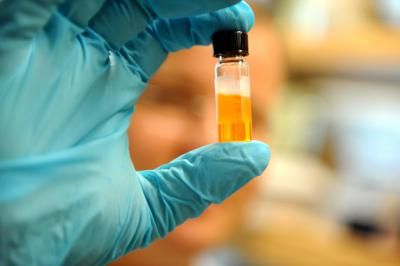A new method for coating individual luminous nanocrystals (quantum dots) with silicon dioxide
Advertisement
Great things are expected from quantum dots: they are supposed to mark tumors, help improve large flat-screens, and be the foundation for the optical data processing of the future. quantum dots are nanoscopic crystals, which are so small that their optoelectronic properties resemble those of single molecules-even though they are otherwise solid materials. However, it takes the right coating to make the little guys fully functional. German and Australian collaborators have now developed a new, robust method to easily coat tiny crystals that consist of a cadmium selenide core with a shell of zinc sulfide (CdSe/ZnS) with silicon dioxide, so that each sphere of silicon dioxide contains exactly one quantum dot.
Native CdSe quantum dots are only stable in nonpolar solvents. However, polar, protic media (media that can transfer protons to solvated compounds) are unavoidable in many applications; biomedical uses, for example, require an aqueous environment. The luminous dots must thus be coated for stabilization, protection from oxygen, and prevention of deposits that interfere with the luminescence. However, the coating itself must also not impede the luminescence and needs to be biocompatible. A layer of silicon dioxide fulfils these requirements. Thomas Nann of the Freiburg Materials Research Center explains the dilemma: "The usual methods for producing silicon dioxide coatings require polar solvents to begin with."
Together with Paul Mulvaney of the University of Melbourne, Nann developed a new coating method. The CdSe/ZnS nanocrystals are initially provided with a coating made of surface-reactive organic phosphorus compounds, which are then replaced stepwise with polar ligands. The ligand of choice is a special organic sulfur-containing silicon compound. After the exchange, the nanocrystals can be transferred to a polar, protic solvent, ethanol. The solution also contains tetraethoxysilane (TEOS) as well as small amounts of water and ammonia, which catalyze the decomposition of TEOS to silicon dioxide. This is then deposited on the nanocrystals. The quantities of all the "ingredients" must be precisely controlled. According to Nann, "enough silicon dioxide must be formed for deposition to proceed; however too much results in surplus empty spheres." In addition, the growing particles must not clump together, as this forms "raisin buns", spheres containing multiple quantum dots. Water helps to prevent this by promoting the electrostatic charging of the particle surfaces, causing them to repel each other. Successive additions of TEOS allow for additional coating of the spheres, making diameters of 30 nm to 1µm attainable.
Most read news
Topics
Organizations
Other news from the department science

Get the chemical industry in your inbox
By submitting this form you agree that LUMITOS AG will send you the newsletter(s) selected above by email. Your data will not be passed on to third parties. Your data will be stored and processed in accordance with our data protection regulations. LUMITOS may contact you by email for the purpose of advertising or market and opinion surveys. You can revoke your consent at any time without giving reasons to LUMITOS AG, Ernst-Augustin-Str. 2, 12489 Berlin, Germany or by e-mail at revoke@lumitos.com with effect for the future. In addition, each email contains a link to unsubscribe from the corresponding newsletter.































































